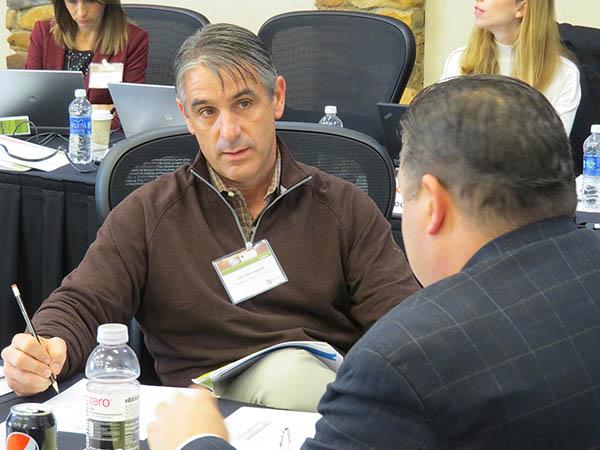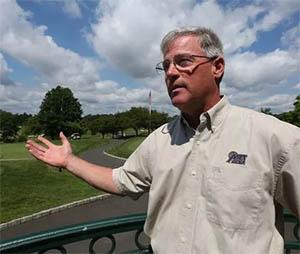Long before the phrase "fake news" became part of the pop culture vernacular, stopping the spread of misinformation was an oft-used tactic in golf.
 Before anyone waives a finger at the turf media crying "fake news,", let it be known that the purveyors of false truths in this business often are golfers who do not have the correct information about what is going on at their golf course. Uninformed and left to their own devices, they will draw their own conclusions about why there is dead turf on No. 3 or dry spots on the 15th green. If there are issues with irrigation coverage or an onslaught of anthracnose sweeping through the Mid-Atlantic, they don't know the truth if someone does not take time to tell them. All they know is it appears someone is not doing their job, and that's when trouble can begin.
Before anyone waives a finger at the turf media crying "fake news,", let it be known that the purveyors of false truths in this business often are golfers who do not have the correct information about what is going on at their golf course. Uninformed and left to their own devices, they will draw their own conclusions about why there is dead turf on No. 3 or dry spots on the 15th green. If there are issues with irrigation coverage or an onslaught of anthracnose sweeping through the Mid-Atlantic, they don't know the truth if someone does not take time to tell them. All they know is it appears someone is not doing their job, and that's when trouble can begin.John Cunningham, CGCS, the director of agronomy and assistant general manager at Bellerive Country Club in St. Louis always believed he was pretty good at communicating with members during a career that has included stops at handful of top clubs across three states. Today, he knows he's a great communicator, and he has a golfer at the Four Seasons Resort in Irving, Texas to thank for it.
"I had a green chairman at the Four Seasons who was a communications executive with a Fox affiliate, and he always told me, 'John, you can never over-communicate,' " Cunningham said. "That has always stuck with me."
That ability also has come in handy for Cunningham, as well as many other professional turf managers.
Nowadays, Cunningham writes a newsletter and sends out numerous emails to his members about what is taking place. Whether it is something simple about the ins and outs of hand-water or hydrojecting, and how both can help him and his team maximize playing conditions or what is being done to repair bentgrass greens that didn't make it through the summer, Cunningham keeps his members in the know about everything.
"Communication is like managing turf: It can be preventive or curative," he said. "I prefer preventive over curative. I'd rather spend time on the front end. For those who say they don't have time to always send out emails ahead of time, tell me when you're having to put out fires how much time that takes.
"Our job is to put out fake news."
Whether it's Twitter, Facebook, email, a newsletter or some other avenue doesn't much matter, as long as it reaches members, Cunningham said.
"You have the ability to snap a picture with your phone and in five minutes let everyone in on what is going on ," he said.
"A lot of members here don't play golf every week. They don't know what is going on here all the time. Our approach is to take everyone along for the ride," he said. "When you do newsletter, do you print it put it on wall in locker room? Is that old school? I don't think so. It's just another platform."
His members appreciate being kept in the loop about everything that is taking place on their property.
"I just want to know what is going on said Tom Schneider, M.D., a St. Louis-area surgeon and a former green chairman at Bellerive. "People are always asking questions. It's better for everyone to see what is going on. That helps keep the rumors away.
"Surprises are terrible in this kind of environment."
Josh Clevenger also learned the fine art of communication from a golfing member at Claremont Country Club in California.
When Clevenger was hired as an assistant about seven years ago under longtime superintendent Randy Gai, Claremont's green chairman was an advertising executive "who would bang his hand on the table and say 'you can't communicate enough,' " Clevenger said.
 To that end, Clevenger maintains a blog, sends out periodic emails, writes a weekly report for the club web site and, just as important, spends time where golfers can have access to him.
To that end, Clevenger maintains a blog, sends out periodic emails, writes a weekly report for the club web site and, just as important, spends time where golfers can have access to him."On Saturday mornings, I spend time in the golf shop," he said. "Blogging is one thing. It's another to be face to face with people who don't go on the blog.
"I should have minored in communication for all the writing I do."
Communicating with golfers is a journey, not a destination, says Matt Ceplo of Rockland Country Club in Sparkill, New York, because no matter how much information a superintendent tries to share with golfers, a sizeable chunk of the target population won't ever see it.
"I'm not saying it's not important. I'm not saying don't do it," Ceplo said. "Do more. Just don't assume it is all read. That's why it's also important to be visible and answer questions."
It is equally important, Ceplo said, to communicate all of your good news. When the course is purring along on all eight cylinders, that is when superintendents often have freedom for pet projects and other things.
"If you are hosting a girl scout troop and that gets picked up in the paper, members get a kick out of that. They enjoy that. As long as you have good greens, tees and fairways you can do things like that," Ceplo said. "You don't want them to see you hosting a bird count if you have dead greens. You have to pick and choose places and be aware that everything fits in a pecking order."
There is more to being successful than communicating only with golfers. Since superintendents largely operate behind the scenes, at least compared with other departments within a golf facility, it is important to educate those who might be asked to speak on your behalf.
"I have a pro who is a great communicator and is very supportive of me," Clevenger said. "Keeping him in the loop is important, making sure he and his staff have the right information and answers for golfers."
Communicating across departments was imperative when Cunningham was at the Four Seasons, a resort property with a hotel, two golf courses, an annual PGA Tour event and 800-plus employees.
"The reservations department has to know what was planned for the golf course 16 months from now when someone is booking it," he said.
"Everyone knew what was going on. Everyone worked together."
That's good, because fake news and surprises are terrible in this business.

